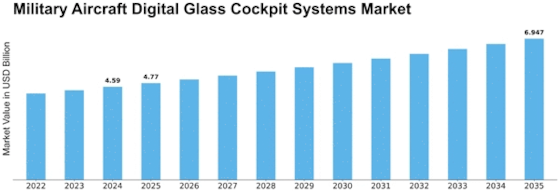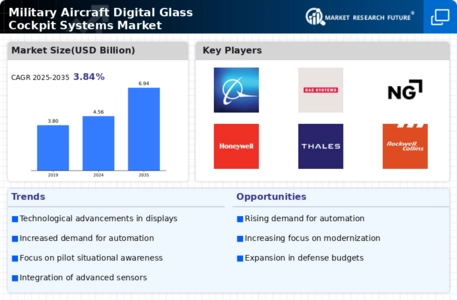Military Aircraft Digital Glass Cockpit Systems Size
Military Aircraft Digital Glass Cockpit Systems Market Growth Projections and Opportunities
The military aircraft digital glass cockpit systems market is undergoing significant transformations driven by various market factors that influence its dynamics. A primary catalyst for this market is the increasing integration of advanced avionics technologies in military aircraft. Digital glass cockpit systems, characterized by electronic displays and intuitive interfaces, offer enhanced situational awareness, reduced pilot workload, and improved mission effectiveness. As military forces globally seek to modernize their fleets, the demand for state-of-the-art cockpit systems continues to grow.
Technological advancements play a pivotal role in shaping the market factors of military aircraft digital glass cockpit systems. Ongoing innovations in display technologies, processing power, and connectivity contribute to the development of more sophisticated and capable cockpit solutions. High-resolution displays, touchscreens, and integration with advanced avionics systems enhance the overall performance and functionality of digital glass cockpits, meeting the evolving needs of modern military operations.
Global geopolitical considerations significantly impact the market dynamics of military aircraft digital glass cockpit systems. Defense budgets, strategic priorities, and regional security concerns influence the procurement decisions of military forces. As nations invest in the modernization of their air forces, the adoption of digital glass cockpit systems becomes a crucial component of upgrading existing fleets and integrating new aircraft with cutting-edge avionics technologies.
Regulatory standards and compliance requirements are integral market factors for military aircraft digital glass cockpit systems. Military aviation operates under stringent safety and performance regulations. Digital cockpit systems must adhere to these standards to ensure airworthiness and interoperability with existing military platforms. Compliance with evolving regulations, such as cybersecurity protocols, is essential for manufacturers and suppliers to meet the rigorous requirements of military customers.
Cost considerations play a significant role in shaping the market dynamics of military aircraft digital glass cockpit systems. Defense budgets are often constrained, requiring military organizations to balance the need for advanced technologies with budgetary constraints. Manufacturers and suppliers must provide cost-effective solutions without compromising on the quality, reliability, and capabilities of digital glass cockpit systems to remain competitive in the market.
Innovation and competition drive advancements in military aircraft digital glass cockpit systems. Manufacturers are continually developing new features, software applications, and human-machine interface designs to offer cutting-edge solutions. The competitive landscape encourages innovation, resulting in more customizable, user-friendly, and mission-specific cockpit systems that cater to the diverse requirements of military operators.
Environmental sustainability considerations are increasingly influencing the market dynamics of military aircraft digital glass cockpit systems. While the primary focus in military aviation is often on performance and capability, there is a growing awareness of the environmental impact of defense operations. Manufacturers are exploring ways to optimize energy efficiency, reduce electronic waste, and implement eco-friendly manufacturing processes in the development of digital cockpit systems.
The interoperability of digital glass cockpit systems with existing and future avionics platforms is a critical market factor. Military forces operate a variety of aircraft with diverse avionics architectures. Compatibility and integration capabilities of digital cockpit systems with legacy systems and emerging technologies are essential for ensuring seamless communication and coordination in mixed fleets.


















Leave a Comment